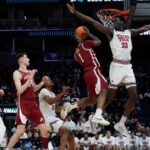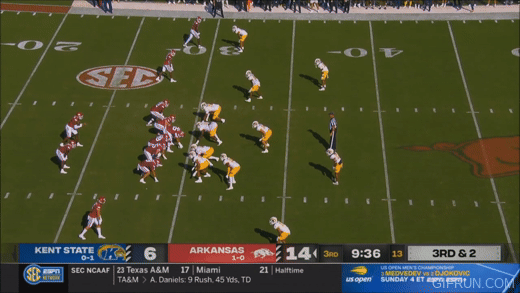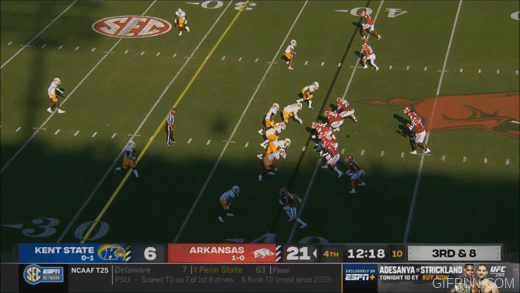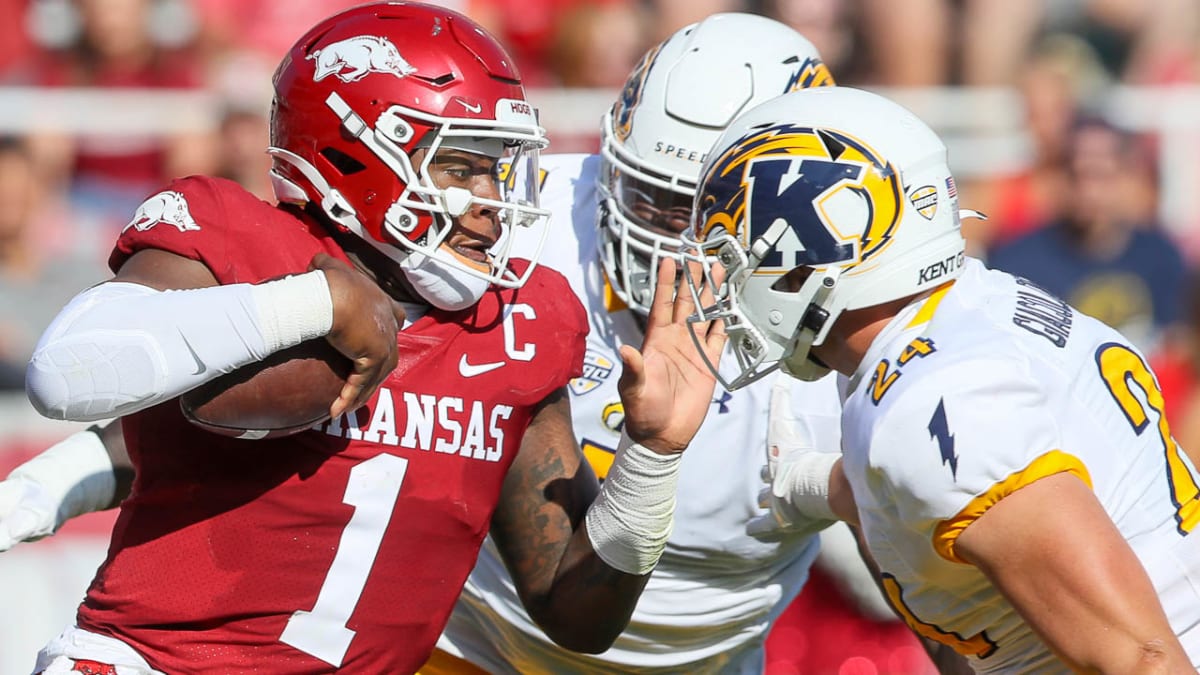It was ugly, but Arkansas was in control for most of the game and beat Kent State 28-6 to start 2-0.
Without Rocket Sanders, the Hogs again struggled to run the ball, though they eventually got things moving, dominating time of possession in the second half and controlling the game’s final 30 minutes.
Key Moments
Here were the biggest moments in the game, based on win probability added (WPA):
- +30% – Jahiem Thomas’s sack when Kent State had 1st and 10 at midfield in the second quarter
- +23% – Antonio Grier’s pick-six
- +15% – Kent State punting on 4th-and-7 from the Arkansas 48 in the second quarter
This game was won the Hogs in the second quarter, where five of the top seven plays occurred. Despite trailing 7-3, the Golden Flashes began the second quarter with possession and a 58% chance to win. The half ended with Kent State’s win probably at just 18%. Nothing in the second half had a major impact on the eventual winner.
Here were Arkansas’ top offensive contributors by WPA:
- KJ Jefferson +40%
- Isaac TeSlaa +11%
- Luke Hasz +7%
- What Arkansas is getting in Nick Pringle and Malique Ewin

- Box Score Breakdown: Texas Tech 85, Arkansas 83

- Matchup Analysis: 3 Texas Tech

Advanced Stats

This result was not fluky: if anything, a good field kicker and about three points worth of penalties helped Kent State not lose by even more.
The noise-canceled final score is Arkansas 18, Kent State 3. You can read about how the metric is calculated here, but essentially it tries to cancel out “noise”, which are high-leverage, game-changing plays that could have gone either way, namely third downs (especially third-and-longs), turnovers, penalties, non-offensive touchdowns, and field goals. The Hogs lose their pick-six and take a small penalty for being behind the chains on two of their touchdown drives (including needing a third-and-12), while Kent State also loses a couple points for falling behind the chains on both field goal drives.

The Hogs did Enos things on offense: no turnovers, long drives, few negative plays, and cashing in scoring chances. Not counting the final, run-out-the-clock drive against Kent State, Arkansas has gotten a first down inside the opponent 40 on 10 drives this season. All 10 have ended in touchdowns. That’s quite a break from what we saw last year.
Arkansas also has zero turnovers and is averaging 47 net yards per punt. Opponents have only started two drives this year past their own 35, which is amazing. The Arkansas offense is giving its defense a chance.
Kent State had four scoring chances as well, but those ended with two field goals, a punt (after the Hog failed fourth down), and a goal-line stand. The Hogs were a bit bend-don’t-break, but it worked well.
Last note: both teams had just nine drives all game. If you take out both end-of-half drives by Arkansas, the Hogs had just seven full offensive possessions. Before getting concerned about gaining fewer than 400 yards of offense for the second straight game, consider that the new clock rules (the clock runs after first downs outside of the final two minutes of each half, as in the NFL) are shortening the game. That played a role in Arkansas’ slow offensive start to this one.

The Hogs stayed decently on-schedule (78% leverage rate) and were pretty efficient (50% success) and decent on standard downs (+0.11), but they just couldn’t generate explosive plays (8%). The explosiveness issue is all in the run game:

The overall numbers aren’t bad: 53% success, and 2.74 line-yards per rush. Those aren’t ideal against a bad MAC defense, but they aren’t awful. Only four non-sack runs were stuffed – that figure was seven per game last year. But again, no big runs. The Hogs are now dead-last in the SEC in yards before contact (YAC) per rush, after the leading the SEC in that stat last year.

Under Kendal Briles, Arkansas was about 70-30 in terms of zone-to-gap ratio on runs. In the opener, it was about 50-50. But for this one, the Hogs were heavy on gap-schemed runs. Almost all zone runs were either at the goal line or on the final drive.

Without Sanders, the Hogs stayed away from Counter (only two for three total yards) and leaned heavily on the pin-and-pull Base run (12 carries, 79 yards, +0.52 EPA/rush, 6 successes, 2 explosives). On Base Reads, AJ Green had three carries for 31 yards (two successful), but the best version of this play was Jefferson on a designed Q Base, which happened six times for 39 yards (four successful):

Other gap looks were a mixed bag. The Dive mostly worked (three of five successful), but Dominique Johnson got blown up on 4th-and-1 in the third quarter on Dive.

Green had 15 carries for 86 yards, +2.1 EPA, and 67% success (10 of 15 runs were successful). He seems to have the best grasp of where the hole is right now. Unlike the Briles scheme, which preferred quick-opening holes to punish aggressive defenses, these gap-schemed runs take a while to develop. Remember Alex Collins chopping his feet and waiting to burst through the hole as it opened. I saw some of that in Green’s running in the second half.
Dubinion and Johnson both had negative yards before contact in this game, and Johnson is still at minus-1 YBC for the season. They’re not finding the hole, so they are reliant on breaking tackles and generating yards after contact. Dubinion has already broken a team-best seven tackles this year and leads the team with 3.5 yards after contact per rush, but most of those broken tackles are at or behind the line of scrimmage, so he’s just making something out of nothing.
Though the backs are slowly adjusting, it’s clear that Arkansas’ line is underperforming right now. The tackles in particular are struggling, and the Hogs were rotating against Kent State trying to find a good combination.

Arkansas’ numbers look ugly due mostly to low volume, though the advanced numbers aren’t great either. Jaedon Wilson had two drops, but Jefferson also missed on a few throws.

The Hogs were very vanilla in the pass game: just eight RPOs and just four play actions. I would expect much more than that when the competition heats up.
Conceptually, the Hogs didn’t really rely on any one look:

The love affair with screens is interesting. Since Wilson went 65 yards on a bubble screen on the second play of the season, the Hogs have tried 12 screens, gaining just 49 yards with only three successes.
This little China concept (also called “Texas”, where an inside receiver or tight end goes out and cuts back in like a slant) was new this week, and worked for a nice third down conversion to Luke Hasz:

All in all, Arkansas wasn’t sharp in either the run or pass game, but this wasn’t just a horrible performance. To be sure, they’ll have to step it up if they want to have a good offense this year.
Up Next
The Hogs routed BYU 52-35 in Provo last year, but the Cougars have reloaded on offense, bringing in USC-then-Pitt transfer QB Kedon Slovis to run the offense. The Cougar defense is a big question mark, but the offense has the potential to put up a ton of points. The Hogs will have to be ready.
Thanks for reading! Be sure to follow us on Twitter and on Facebook.
The latest from Fayette Villains, straight to your inbox
Enter your email to subscribe and receive new post alerts and other updates. You can unsubscribe at any time.
